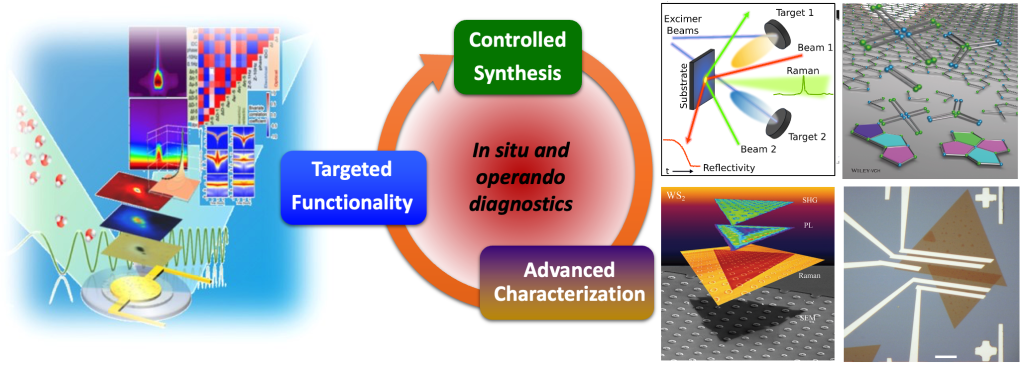The FHN group's mission is "To understand and control nanomaterials synthesis and assembly to elicit special functionalities by integrating real-time diagnostics and advanced characterization techniques."
Functional Hybrid Nanomaterials

The Functional Hybrid Nanomaterials (FHN) Group synthesizes and characterizes 2D materials and thin films, as well as hybrid architectures by a variety of techniques. Synthesis and processing methods include pulsed laser deposition (PLD), chemical vapor deposition and transport (CVD, CVT), exfoliation of 2D materials and atmospherically-controlled stamping, and other techniques such as Sonospray.
The group specializes in optical spectroscopy characterization techniques of nanomaterials, and methods to employ these as in situ diagnostics of a material's structure and properties during synthesis or in operando in response to controlled environments, catalytic reactions, or optical and electrical stimulus. The in situ diagnostic data acquired during synthesis is used to develop growth models for carbon nanotubes, graphene, TMD 2D materials, Janus monolayers, and thin films.
The group is heavily involved in automating synthesis incorporating in situ diagnostics and characterization to enable the development AI/ML approaches for autonomous synthesis. Signature automated PLD facilities incorporate in situ RHEED, XPS/XPD, Raman spectroscopy, and data acquisition.
Raman, PL, SHG, vis-UV, and reflectance spectroscopies are used to map 2D materials and develop optoelectronic, sensing, and catalytic functionalities. Multimodal ‘lab on a crystal’ QCM-based platforms are used to correlate electrical, optical, and gravimetric/viscoelastic properties of thin films with environmental effects using AI and ML.
Raman and PL micro-spectroscopy is performed in several different environments, including rapid mapping capabilities, tunable laser excitation, low-frequency Raman modes, and cryogenic environments. Ultrafast laser micro-spectroscopy is used to measure quasiparticle dynamics of 2D materials and heterostructures, while cathodoluminescence spectroscopy with nm-resolution is coupled with single superconducting nanowire detection for quantum correlation measurements of single-photon emitters.

